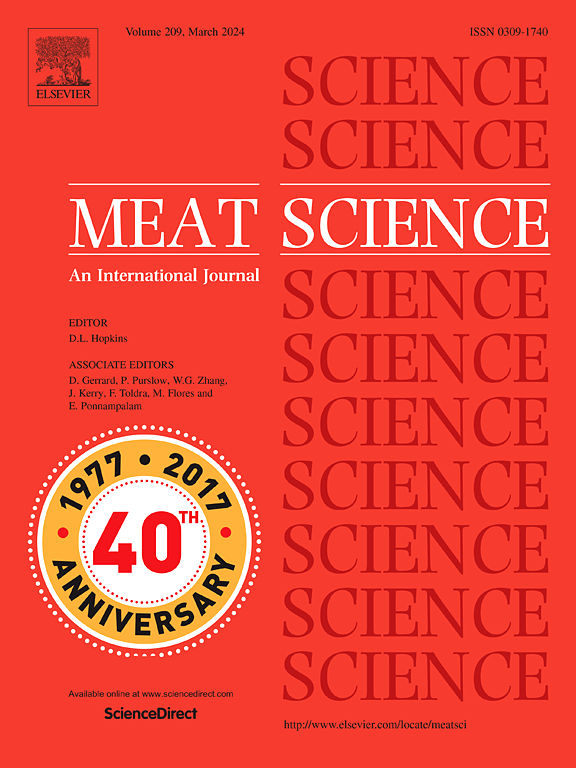Mycotoxins in meat products
IF 6.1
1区 农林科学
Q1 Agricultural and Biological Sciences
引用次数: 0
Abstract
Mycotoxin presence in meat products is principally due to the development of toxigenic moulds during ripening, which concretely affect the dry-cured ones. Ochratoxin A (OTA) is the most prevalent mycotoxin in dry-cured hams and fermented sausages. Apart from collecting information on the main toxigenic moulds in dry-cured meat products, the objective of this review is to compile data about the mycotoxin prevalence and the tools for their mitigation. Although no very extensive studies have been performed on the mycotoxin occurrence in such products, much research has been conducted over the last 15 years, particularly in the European Mediterranean countries. Large differences in OTA incidence and amount have been reported, which can be due to differences in the processing followed, the climatic conditions of the producing region, the mould population present or the used detection method. Nevertheless, most of the mean and maximum OTA values observed in dry-cured meat products are above the maximum level of 1 μg/kg recommended officially for pork products in Italy. Aflatoxin B1, cyclopiazonic acid, sterigmatocystin and citrinin are only occasionally reported from dry-cured meat products. To control mycotoxin contamination, manufacturers have several strategies available, with the biopreservation ones being the most appropriate, since the modification of environmental parameters is not feasible, especially in products with long ripening. Native microorganisms alone or in combination with plant extracts are sustainable biopreservatives with a special interest in dry-cured meat products to mitigate the mycotoxin contamination. All these strategies are extensively described in this review, with special attention paid to OTA.
肉制品中的霉菌毒素
肉制品中霉菌毒素的存在主要是由于在成熟过程中产生的产毒霉菌的发展,这具体影响了干腌肉制品。赭曲霉毒素A (OTA)是干腌火腿和发酵香肠中最常见的真菌毒素。除了收集有关干腌肉制品中主要产毒霉菌的信息外,本综述的目的是汇编有关霉菌毒素流行率的数据和减轻其影响的工具。虽然没有对此类产品中的霉菌毒素进行非常广泛的研究,但在过去15年中进行了大量研究,特别是在欧洲地中海国家。据报道,在OTA发病率和数量上存在很大差异,这可能是由于随后的加工、产地的气候条件、存在的霉菌数量或使用的检测方法的差异。然而,在干腌肉制品中观察到的大多数平均和最高OTA值都高于意大利官方推荐的猪肉产品最高水平1 μg/kg。黄曲霉毒素B1,环吡唑酸,sterigmatocystin和柑桔霉素只是偶尔报道从干腌肉制品。为了控制霉菌毒素污染,制造商有几种可用的策略,其中生物保存策略是最合适的,因为环境参数的修改是不可行的,特别是在长时间成熟的产品中。原生微生物单独或与植物提取物组合是可持续的生物防腐剂,对干腌肉制品有特殊的兴趣,以减轻霉菌毒素污染。所有这些策略在这篇综述中都有广泛的描述,特别关注在线旅行社。
本文章由计算机程序翻译,如有差异,请以英文原文为准。
求助全文
约1分钟内获得全文
求助全文
来源期刊

Meat Science
工程技术-食品科技
CiteScore
12.60
自引率
9.90%
发文量
282
审稿时长
60 days
期刊介绍:
The aim of Meat Science is to serve as a suitable platform for the dissemination of interdisciplinary and international knowledge on all factors influencing the properties of meat. While the journal primarily focuses on the flesh of mammals, contributions related to poultry will be considered if they enhance the overall understanding of the relationship between muscle nature and meat quality post mortem. Additionally, papers on large birds (e.g., emus, ostriches) as well as wild-captured mammals and crocodiles will be welcomed.
 求助内容:
求助内容: 应助结果提醒方式:
应助结果提醒方式:


